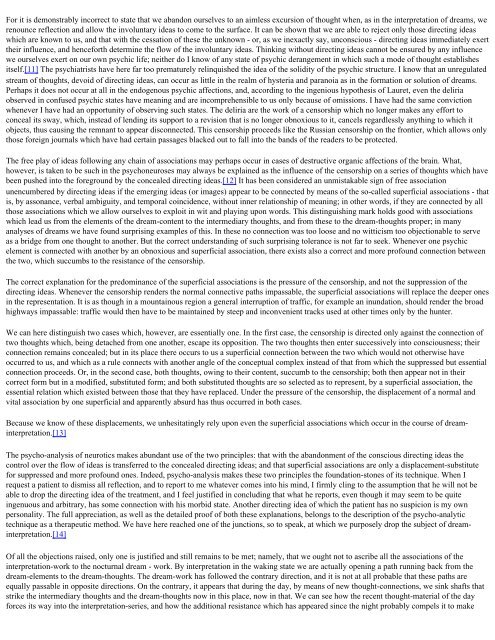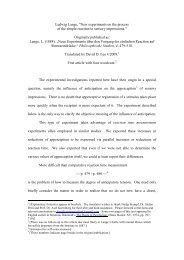The Interpretation Of Dreams Sigmund Freud (1900) PREFACE
The Interpretation Of Dreams Sigmund Freud (1900) PREFACE
The Interpretation Of Dreams Sigmund Freud (1900) PREFACE
You also want an ePaper? Increase the reach of your titles
YUMPU automatically turns print PDFs into web optimized ePapers that Google loves.
For it is demonstrably incorrect to state that we abandon ourselves to an aimless excursion of thought when, as in the interpretation of dreams, we<br />
renounce reflection and allow the involuntary ideas to come to the surface. It can be shown that we are able to reject only those directing ideas<br />
which are known to us, and that with the cessation of these the unknown - or, as we inexactly say, unconscious - directing ideas immediately exert<br />
their influence, and henceforth determine the flow of the involuntary ideas. Thinking without directing ideas cannot be ensured by any influence<br />
we ourselves exert on our own psychic life; neither do I know of any state of psychic derangement in which such a mode of thought establishes<br />
itself.[11] <strong>The</strong> psychiatrists have here far too prematurely relinquished the idea of the solidity of the psychic structure. I know that an unregulated<br />
stream of thoughts, devoid of directing ideas, can occur as little in the realm of hysteria and paranoia as in the formation or solution of dreams.<br />
Perhaps it does not occur at all in the endogenous psychic affections, and, according to the ingenious hypothesis of Lauret, even the deliria<br />
observed in confused psychic states have meaning and are incomprehensible to us only because of omissions. I have had the same conviction<br />
whenever I have had an opportunity of observing such states. <strong>The</strong> deliria are the work of a censorship which no longer makes any effort to<br />
conceal its sway, which, instead of lending its support to a revision that is no longer obnoxious to it, cancels regardlessly anything to which it<br />
objects, thus causing the remnant to appear disconnected. This censorship proceeds like the Russian censorship on the frontier, which allows only<br />
those foreign journals which have had certain passages blacked out to fall into the bands of the readers to be protected.<br />
<strong>The</strong> free play of ideas following any chain of associations may perhaps occur in cases of destructive organic affections of the brain. What,<br />
however, is taken to be such in the psychoneuroses may always be explained as the influence of the censorship on a series of thoughts which have<br />
been pushed into the foreground by the concealed directing ideas.[12] It has been considered an unmistakable sign of free association<br />
unencumbered by directing ideas if the emerging ideas (or images) appear to be connected by means of the so-called superficial associations - that<br />
is, by assonance, verbal ambiguity, and temporal coincidence, without inner relationship of meaning; in other words, if they are connected by all<br />
those associations which we allow ourselves to exploit in wit and playing upon words. This distinguishing mark holds good with associations<br />
which lead us from the elements of the dream-content to the intermediary thoughts, and from these to the dream-thoughts proper; in many<br />
analyses of dreams we have found surprising examples of this. In these no connection was too loose and no witticism too objectionable to serve<br />
as a bridge from one thought to another. But the correct understanding of such surprising tolerance is not far to seek. Whenever one psychic<br />
element is connected with another by an obnoxious and superficial association, there exists also a correct and more profound connection between<br />
the two, which succumbs to the resistance of the censorship.<br />
<strong>The</strong> correct explanation for the predominance of the superficial associations is the pressure of the censorship, and not the suppression of the<br />
directing ideas. Whenever the censorship renders the normal connective paths impassable, the superficial associations will replace the deeper ones<br />
in the representation. It is as though in a mountainous region a general interruption of traffic, for example an inundation, should render the broad<br />
highways impassable: traffic would then have to be maintained by steep and inconvenient tracks used at other times only by the hunter.<br />
We can here distinguish two cases which, however, are essentially one. In the first case, the censorship is directed only against the connection of<br />
two thoughts which, being detached from one another, escape its opposition. <strong>The</strong> two thoughts then enter successively into consciousness; their<br />
connection remains concealed; but in its place there occurs to us a superficial connection between the two which would not otherwise have<br />
occurred to us, and which as a rule connects with another angle of the conceptual complex instead of that from which the suppressed but essential<br />
connection proceeds. Or, in the second case, both thoughts, owing to their content, succumb to the censorship; both then appear not in their<br />
correct form but in a modified, substituted form; and both substituted thoughts are so selected as to represent, by a superficial association, the<br />
essential relation which existed between those that they have replaced. Under the pressure of the censorship, the displacement of a normal and<br />
vital association by one superficial and apparently absurd has thus occurred in both cases.<br />
Because we know of these displacements, we unhesitatingly rely upon even the superficial associations which occur in the course of dreaminterpretation.[13]<br />
<strong>The</strong> psycho-analysis of neurotics makes abundant use of the two principles: that with the abandonment of the conscious directing ideas the<br />
control over the flow of ideas is transferred to the concealed directing ideas; and that superficial associations are only a displacement-substitute<br />
for suppressed and more profound ones. Indeed, psycho-analysis makes these two principles the foundation-stones of its technique. When I<br />
request a patient to dismiss all reflection, and to report to me whatever comes into his mind, I firmly cling to the assumption that he will not be<br />
able to drop the directing idea of the treatment, and I feel justified in concluding that what he reports, even though it may seem to be quite<br />
ingenuous and arbitrary, has some connection with his morbid state. Another directing idea of which the patient has no suspicion is my own<br />
personality. <strong>The</strong> full appreciation, as well as the detailed proof of both these explanations, belongs to the description of the psycho-analytic<br />
technique as a therapeutic method. We have here reached one of the junctions, so to speak, at which we purposely drop the subject of dreaminterpretation.[14]<br />
<strong>Of</strong> all the objections raised, only one is justified and still remains to be met; namely, that we ought not to ascribe all the associations of the<br />
interpretation-work to the nocturnal dream - work. By interpretation in the waking state we are actually opening a path running back from the<br />
dream-elements to the dream-thoughts. <strong>The</strong> dream-work has followed the contrary direction, and it is not at all probable that these paths are<br />
equally passable in opposite directions. On the contrary, it appears that during the day, by means of new thought-connections, we sink shafts that<br />
strike the intermediary thoughts and the dream-thoughts now in this place, now in that. We can see how the recent thought-material of the day<br />
forces its way into the interpretation-series, and how the additional resistance which has appeared since the night probably compels it to make



